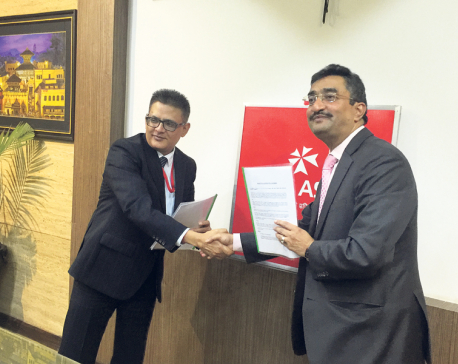
OR
Relevance of government on health insurance scheme
Published On: September 23, 2018 08:33 PM NPT By: Ruku Pandey
The issue of health insurance used to be hot cake in the parliament, among bureaucrats, politician, academicians, policy makers and media people including the elite public but at present, nobody raised the issue anymore. Nobody knows what is going on? The state Nepal has been newly structured into 7 provincial states, the new constitution has been promulgated, despite that, there are many challenges to meet the expectation of the people in the health insurance sector including others. There is no doubt that Health policy of Nepal has been definitely influenced by Alma Ata declaration of 1978 which emphasized the provision of community-oriented preventive, promotional and curative health service and evident by the establishment of a network of primary health care facilities and development of community health workers to provide essential health service at the community level. Health security insurance scheme launched by the Government of Nepal seems very good but it is still limited to a certain district of Nepal, people at large are not aware of this scheme. It is the responsibility of the Government to sensitize the people so they can have benefited from the provided service.
The Constitution of Nepal addresses that health as a fundamental right, stating that every citizen has the right to basic health services free of cost but in reality, it is a far from the cry. Only 61.8% of the Nepalese households have access to health facilities with significant urban (85.9%) and rural (59%) discrepancy. On February 2015, the Government of Nepal formed a Social Health Security Development Committee as a legal framework to start implementing a Social Health security scheme (SHS) after the National Health Insurance Policy came out in 2013. The government of Nepal under the comprehensive social contributory scheme first implemented the health security insurance programme in Bhaktapur, Chitawan and Baglung district. Based on this, the government has brought Health Insurance Act which covers free access to Yoga, immunization, family planning, safe motherhood, out-patient care, in-patient care, surgery, medicines, emergency care, curative service, rehabilitation service among others. Individual, family, civil servants, migrant workers and private sector employees can enroll in this scheme.
Those who seek health insurance must pay in Nepal; provision of free health care in poor countries is challenged by weak income, small tax base, large informal sector, donor dependency and high dependence on international trade. Poor countries strive to establish social health insurance, new challenges emerge, including troubles in arriving at a national consensus for health insurance schemes structure, income inequalities, weak government managerial capacity and poor infrastructure which limits the facilitation of collections, reimbursements and monitoring.
Health insurance absorbs or offsets healthcare costs associated with, but not limited to, routine health examinations, specialist referral visits, and inpatient and outpatient surgery, unforeseen eventualities such as illnesses or injuries, and prescription medication. Health insurance policies are categorized as privately paid for by an individual, publicly provided as a service through Social Security, or commercially arranged by a company as part of an employee benefits package. Broader levels of health insurance coverage generally have higher premium costs. In many cases, the insured party is responsible for paying his/her healthcare provider an up-front, tax-deductible amount called co-pay. Health insurance companies then may compensate healthcare providers directly or reimburse the policyholder based on the remaining portion of an itemized bill.
While doing research on health insurance practices around the work, I came to know that restructuring of health care system is occurring all over the world. The most frequently cited welfare state typology was developed by Epping-Andersen (1990) who identified three distinct regime types in western nations; each has a different effect on the class structure. "Social democratic" regimes provide extensive welfare benefits granted to all as a right of citizenship, with private benefits having only a marginal place. The primary exemplars of this strategy are the Scandinavian countries of Sweden, Norway, and Finland. "Conservative" regimes are found in Catholic countries and are more concerned with supporting the traditional family and maintaining hereditary status relationships. Countries in this category include France, Germany, Italy, and Austria. Finally, "liberal" welfare states are characterized by an extensive reliance on means-testing, a preference for the market over the state, and government subsidies to encourage private welfare. The United Kingdom, Canada, Australia, and the United States are typically considered liberal welfare states. Although other social scientists have modified these categories somewhat or added additional types that include non-western nations.
The study of our neighboring country India shows that community-based health insurance was found effective is an appropriate way of reaching the poor in comparison to the market-mediated or government-provided insurance. The private health insurance policies are pretty much inclined toward those who can afford to buy insurance and those poor who can’t afford must suffer until and unless if there is no public subsidy provided by the government. The private insurance policies are found struggling hard to meet their target because of the governments’ limited ability to marshal sufficient resources to finance health spending. This is also because of the nature of employment where a majority of workers are self-employed or do not have a formal employer or steady employment is such that there is little scope for payroll taxes. The private insurance has certain drawbacks such as leaving out low-income individuals who may not be able to afford the premium and denying coverage to people who are sick and limiting coverage for high-cost conditions or services. In the other side, public health insurance policy also does not work properly. The government provided free public health-provision did not work well in the most state of India because of shrinking budgetary support to the public health services, inefficiency in the provision and unacceptable low quality of these services is reflective of this problem. In India, public health care suffers because of poor management, low-quality service; weak finance and lack of responsiveness to patients need and demand.
While comparing a different kind of health insurance policies existing around the world, I found that community-based health insurance effective and good because of its features such as the voluntary participation of people, not for profit, objective scheme management by the community itself and some degree of risk pooling. The real benefit of community-based health insurance lies in keeping the transaction costs low, in designing a scheme suited to community need, in influencing health behavior through health education and affecting the supply of health care.
In comparison to the other countries, health facilities available in Nepal is very poor and for those who are economically poor has to face additional challenges to afford the provided scheme by the government of Nepal through the constitution, granted the basic health facility as a fundamental right to its citizen. The management of the resource and capability of the state is a major problem in Nepal in the health sector. Especially, in the case of those people who have low income. The most important facility to the people is becoming expensive day by day in terms of income. Those people who have a good source of income can have good opportunities to get health facilities available in Nepal but those with low income may adversely be affected. I hope, the government of Nepal will look after those poor who can’t afford the provided scheme and have the right to basic health services free of cost.
The author is sociologist by profession, can be reached at rukupandey2016@gmail.com
You May Like This

12,695 families associate with government health insurance scheme in Kaski
POKHARA, Jan 15: Some 65 thousand citizens have registered their names for the Health Security Insurance (HSI) programme in a... Read More...

Health Insurance Scheme finally comes into being
KATHMANDU, Oct 11: A meeting of Legislature-Parliament on Tuesday passed the bill related to providing health services through insurance to... Read More...

NIC Asia, Shikhar Insurance join hands
KATHMANDU,July21: NIC ASIA Bank has announced business tie up with Shikhar Insurance for promotion of a new non-life insurance product. Read More...
Just In
- KMC to organize a month-long skill fair from May 1
- Birgunj Metropolis collects over Rs 360 million in revenue
- NEPSE plunges below 2,000 points after one and a half months; daily turnover declines to Rs 2.10 billion
- AI Index Report-2024: AI still behind humans on complex tasks like competition-level mathematics
- Daiji-Jogbudha road construction at snail’s pace
- Govt fails to adopt podway technology despite its potential in Nepal
- Jhulaghat border crossing in Baitadi to remain closed from this evening
- Universities will be free from partisan interests: Education Minister



















Leave A Comment